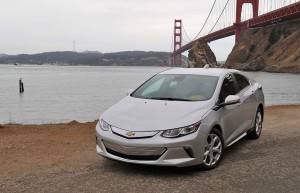Even though the price of gasoline has dropped precipitously, slowing the move towards more efficient vehicles, as of October, there were about 375,000 plug-in electric vehicles (EVs) on America’s roads, according to data collected by the Natural Resources Defense Council.
At the same time, the number of different EV models available has grown from two in 2010 to over 29 today. That is encouraging, and we’ll need to continue to expand electric vehicle availability and adoption to meet our long-range climate targets, NRDC latest report on electric vehicle adoption noted.
The NRDC has long favored using electric and earlier this year sponsored joint research with the Electric Power Research Institute that suggested fueling transportation through electricity instead of oil could be a huge lever for reducing carbon pollution.
The study found that by charging vehicles and off-road equipment with clean energy like wind and solar, we could reduce carbon pollution by 550 million metric tons annually in 2050 – equivalent to the emissions from 100 million of today’s passenger cars. At the same time, wider use of EVs could reduce other air pollutants, such as ozone and particulate matter that threaten our environment and health.
(Rome, Milan latest cities to cut cars to curb pollution. For more, Click Here.)
The NRDC also noted that governments around the world are recognizing the need to shift to EVs with no tailpipe emissions. During the recent Paris climate talks, leaders from 13 jurisdictions from North America and Europe announced an International Zero-Emission Vehicle (ZEV) Alliance and set a goal “to make all passenger vehicle sales in our jurisdictions ZEVs as fast as possible, and no later than 2050,” the report noted.
The conference also suggested implementing a range of policies to support zero-emission vehicle adoption, including investments in plug-in electric charging stations. California is setting the stage for electric utilities to help advance charging infrastructure.
(Click Here to see how the new Paris climate accord will impact motorists.)
Landmark climate legislation passed this year directs the electric industry to propose “programs and investments to accelerate widespread transportation electrification to reduce dependence on petroleum, meet air quality standards, achieve the goals set forth in the Charge Ahead California Initiative, and reduce emissions of greenhouse gases to 40% below 1990 levels by 2030 and to 80% below 1990 levels by 2050,” the report noted.
Basically, California’s utility industry will now have to electrify cars, trucks, and buses in a manner that supports the grid and ensures more people have access to a cleaner transportation fuel that’s the cost-equivalent of dollar-a-gallon gas.
(Tokyo wants its cars to go green in time for the Olympics. Click Here for the story.)
Leaders from several Northeast region states supporting the ZEV program have announced joint efforts to focus on regional policies that will further cut transportation carbon pollution. This will undoubtedly include strengthening standards for car and truck efficiency and accelerating the use of electric vehicles.


As if the NRDC is a reputable entity looking out for society… They are not. They have a political agenda just like other unscrupulous entities. It’s laughable to try an use the false premise that the U.S. is dependent on foreign oil when it is not.
While we’re electrifying the world, lets make sure we divulge that 40% of all commercial electricity produced in the U.S. comes from coal. With politicians talk foolishness about zero emissions EV’s that are dependent on fuel (electricity) from the grid…they are talking about fuel produced primarily from coal, which is not exactly the cleanest fuel in the world and certainly not even remotely close to zero emissions. So while they may believe they are cleaning up the air, they by necessity need additional electrical capacity from the grid to support the electrical demands of EVs. That electricity will come primarily from coal. There is no known method to produce electricity for the grid with even remotely close to zero emissions.
Just as with gasohol, the zero emissions dream is a complete lie. The talking heads don’t want the public to know the cradle to grave consequences of EVs, air pollution and battery toxins. Soon however the politicians will no longer be able to hide reality from tax payers who will be forced to pay for these political pipe dreams. The reason why EVs are slowly growing in numbers is because auto mfgs. have a gun to their head and have no choice with 2025 RPA mandated 54.5 mpg CAFE requirements. Consumers however are effectively ignoring EVs because they are impractical for most of society. All the shilling and deception isn’t going to convince informed consumers that EVs are logical or practical.
BTW, the reason off road heavy equipment is not electric powered is because solar or wind is unable to even remotely produce sufficient power to operate these machines which require high power. Equipping these machines with batteries is foolish when hydrogen fuel cell power is far better for the environment without the toxic battery banks that would be required with battery electric powered machinery. The foolishness promoted by the clueless will never achieve the dream. Only application of proper tech will improve the environment.
“Moon Beam” Brown thinks that Caterpillar Equipment can be converted to 5000 double AA batteries. Just like the dribble out of the White House, you can say anything, but there is never any Practical Back-up. let’s see how Air Farce One can fly on solar and wind power.
Be careful… the flat Earth society members here will make personal attacks on you for pointing out the technical flaws in their beliefs.